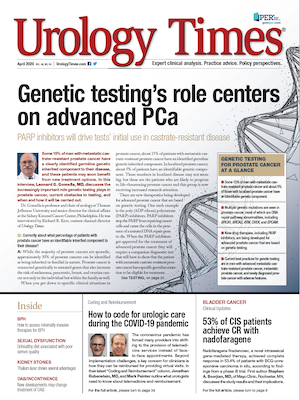Publication
Article
Urology Times Journal
Surveillance safe for patients with Grade Group 1 prostate Ca
Author(s):
"Death due to prostate cancer was quite rare, with only four men (0.2%) dying of prostate cancer during the study period," writes Badar M. Mian, MD.

“Journal Article of the Month” is a new Urology Times section in which Badar M. Mian, MD (left), offers perspective on noteworthy research in the peer-reviewed literature. Dr. Mian is professor of surgery in the division of urology at Albany Medical College, Albany, NY.
Active surveillance (AS) for low-risk prostate cancer is recommended as a viable or preferred option by most professional organizations, and it has gradually gained acceptance by most physicians who manage this condition. Several reports over the last two decades demonstrated the safety of AS for men with very low- or low-risk prostate cancer. An AS approach, unlike watchful waiting, still retains the option to treat, with an intention to cure, if treatment becomes necessary. The natural history of PSA-detected, early-stage prostate cancer is quite long, so long-term safety and efficacy of AS is of particular interest.
Tosoian et al report that AS in men with very low- or low-risk, Grade Group 1 prostate cancer appears to be quite safe, with risk of metastasis or prostate cancer-specific mortality (PCSM) of <1% (Eur Urol Jan. 6, 2020 [Epub ahead of print]). In their large, prospective AS program, 1,818 men were enrolled after the initial prostate biopsy revealed very low-risk (1,293, 71%) or low-risk (525, 29%) prostate cancer.
After enrollment, the initial monitoring protocol included repeat prostate biopsy every year. Multiparametric MRI and mpMRI/ultrasound-fusion targeted biopsy were used since 2013 and 2014, respectively. Five hundred thirty-seven men (30%) underwent pre-enrollment mpMRI, with nearly half (47%) with a positive MRI requiring image-fusion targeted biopsy.
The study enrolled 1,818 patients from January 1995 through June 2018, with 920 men followed for ≥5 years and 305 men for ≥10 years. The median interval between biopsies was 13 months. The cumulative incidence of loss to follow-up at 3, 5, and 10 years was quite low at 3%, 4%, and 6%, respectively. Definitive treatment was offered to all patients with grade reclassification (Grade Group ≥2) on any subsequent prostate biopsy. Treatment or continued AS was offered to men whose repeat biopsy showed increase in volume of cancer (more than two positive cores and/or >50% involvement of a core).
Of the entire cohort, 92 men (5%) died at a median age of 80 years, and of those, 88 were due to non-prostate cancer causes. The cumulative incidence of all-cause mortality was 6.8% at 10 years and 28% at 15 years. Death due to prostate cancer was quite rare, with only four men (0.2%) dying of prostate cancer during the study period. The cumulative incidence of PCSM or metastasis was 0.1% at both 10 and 15 years.
Seven hundred twenty-seven men (40%) underwent biopsy grade reclassification, with the 5-, 10-, and 15-year incidence of grade reclassification of 21%, 30%, and 32%, respectively. The incidence of reclassification to Grade Group ≥3 was 7%, 10%, and 11%, respectively. Of the 693 men who underwent treatment, 78% were due to biopsy reclassification while 22% were due to change in preference. The 5-, 10-, and 15-year incidence of receiving definitive treatment was 36%, 48%, and 52%, respectively.
On multivariable analysis, pre-enrollment mpMRI was associated with a reduced risk of grade reclassification (p=.03). Factors associated with grade reclassification included older age, later year of diagnosis, African-American race, and increased PSAD, number of positive cores, and core involvement. Although the data showed that older age, African-American race, and measures of cancer volume, as well as use of pre-enrollment mpMRI were associated with an increased risk of grade reclassification, these variables did not appear to negatively impact any of the survival outcomes. There does not appear to be any strong rationale to limit African-American patients from enrolling in an AS protocol.
Because the mortality rate (overall and cancer specific) and metastases were so infrequent, the Grade Group reclassification was the most frequent outcome reported. Clearly, grade reclassification should not be viewed as an ominous event since these patients were captured through AS and treated, without negatively affecting their overall survival. Nearly 38% of patients underwent treatment, including those who had a change of heart about AS. No data are provided about the type of definitive treatment received by these patients. It would be instructive to know their pathologic outcomes, recurrence rates, or the need for secondary therapies.
Pre-enrollment mpMRI was associated with a decreased risk of biopsy grade reclassification during follow-up, especially if the mpMRI was negative. It’s not clear from this study whether the mpMRI was used “during” AS and how often. It will be interesting to learn whether these patients with pre-enrollment and/or surveillance mpMRI benefitted in terms of fewer subsequent biopsy sessions or fewer cores taken.
The monitoring protocol reported by the authors is quite stringent, with frequent (annual) repeat biopsies. As active surveillance protocols for low-risk prostate cancer become more widely accepted, there are justifiable concerns about the AS-related morbidity of intensive monitoring. It’s likely that a less invasive surveillance protocol, incorporating better imaging (eg, mpMRI) or genomic testing and fewer biopsies, will not adversely impact the excellent survival outcomes while making AS a more readily acceptable option for low-risk prostate cancer.

























